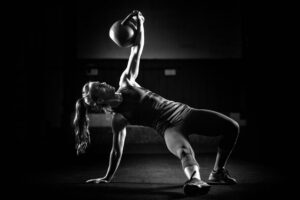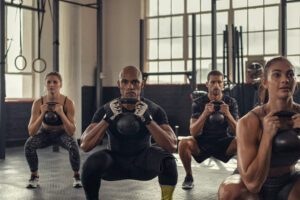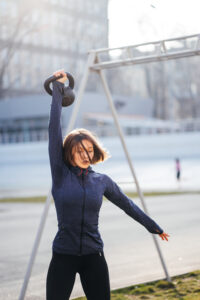So you’re thinking of building a home gym? Are you looking for a way to challenge your entire body and reach peak physical shape, all from the convenience of where you live? If you go the traditional route–dumbbells, barbell, bench, pull-up bar, squat rack, etc.–costs and space requirements add up quickly. The average weightlifting rig with accessories takes up at least 50 square feet of space and can cost thousands of dollars. What if you live in a small dwelling or don’t have the budget for that sort of purchase? Worry not, you can get the benefits of an entire home gym for less than $100. The best part? It takes up less than one square foot. We’re talking about owning one single kettlebell.
Kettlebells are nothing new in fitness. They’ve existed in Russian culture in various forms since the early 1700s. However, it wasn’t until the 1990s that they gained popularity outside of Eastern European special forces training regimens and strongman competitions. Since then, the kettlebell has transformed the mainstream exercise landscape. Tack on gym closures due to COVID-19, and the kettlebell has become a focal point for many individuals’ home routines over the past 12 months.
Unlike dumbbells–where you usually require a pair for an effective workout–a lone kettlebell is more than enough to blast your whole body into great shape. Single-arm kettlebell movements like get-ups, rows and overhead presses are incredibly effective ways to build bilateral strength and decrease muscular imbalances. Additionally, the standard kettlebell swing is one of the best overall exercises that can be performed. It incorporates total body strengthening, forces good posture and gives one heck of a caloric burn. You also do not need an extremely heavy weight to get started. In fact, most trainers recommend you go lighter than you’re comfortable with. Kettlebells in the 20lb to 40lb ranges can start out as little as $25. If you feel like you’re consistently outworking your kettlebell’s weight, you can always add further resistance to any movement in the form of a resistance band.
Below are some useful kettlebell movements that will get you into great shape, all from the comfort of your own living room. Be sure to check in with your healthcare provider prior to starting any exercise routine, and–as always–if something hurts, stop doing it and seek further assistance. The biggest advice we can give is to never round your back in any of these movements, and if you are unsure of how to perform them, check with a certified trainer on proper technique.
Kettlebell swing
This is the bread and butter of most kettlebell routines. The key here is to engage the hamstrings and maintain good posture. Don’t lift the kettlebell, focus more on powering it to the top of the movement (roughly shoulder height) with a hinge motion. A very important disclaimer here is that the kettlebell should NEVER go over your head. Common in U.S. crossfit circles, the overhead kettlebell swing is a very dangerous and unnecessary movement that can cause serious injury risk to your head, neck and shoulders. A good start to a swing routine is 3 to 4 sets of 30 seconds with 30 seconds of rest between. Aim to eventually work that amount up to 5 sets of 30 second swings.


The Turkish get-up
Much like “Bulgarian split squats” or “Romanian deadlifts,” you can file this move under “Eastern European named exercises.” Turkish get-ups are a tremendous total body move that can lead to serious gains. The concept is simple–from a lying position, hold the kettlebell overhead and…get-up, all the while keeping the bell arm completely straight. Before adding weight to this movement, it’s best to practice it with body weight to get the form down. This move does not need a whole ton of sets to be effective. Even just 2 sets of 4 to 6 reps on each side will yield major results.

Goblet squat or split squat
The goblet squat is a great alternative to front squats and the kettlebell split squat is a good alternative to Bulgarian split squats. Hold the bell in front of your torso, engage your core and keep good posture. Lower down slowly on the eccentric and then explode up on the concentric squat. That’s one rep. Aim for 3 to 4 sets of 10 to 12 total reps.

Clean to overhead press
This move is really two moves combined and it works on both explosive power and total strength (especially building up your shoulders). With the kettlebell on the ground in front of you, perform a single-arm power clean, racking the bell between your bicep and tricep, and then press overhead with your arm at roughly a 45 degree angle. Lower it back down to the ground for one rep. Want to gain even more kinetic benefit? Start the kettlebell further away from the moving arm so you have to reach across your body–or pivot–during the initial clean. To avoid adding unnecessary stress to your elbow during the clean, keep your lifting hand’s palm close to your stomach as if you are zipping up a jacket. When you perform the clean, spear your hand through the handle with your fingers pointed straight up to avoid any potential wrist damage.

Single-arm row
Much like a bent-over barbell row, with a flat back, bend over and lift the kettlebell on one side, getting close to your chest at the top of the movement. Using just one bell at a time is a great way to blast your core with instability and work out any muscular imbalances. If this is too challenging, you can always do a tripod row, where you bend over and place the non-lifting hand on a fixed structure–bench, chair, table, counter, etc., all the while keeping both feet on the ground in an athletic stance. Be sure to NEVER do the antiquated single-arm row with one knee on a bench. This is one of the riskiest maneuvers for anyone lifting to try because it significantly increases your risk for an inguinal hernia. Keeping both feet firmly planted on the ground and making a tripod position with your free hand is much safer form.

Suitcase carry
Carries come in many variations–farmer’s, overhead, zercher, etc. If you have a lone kettlebell, you can end your workout with the often underutilized suitcase carry. Suitcase carries are extremely versatile and real-world applicable, as it mimics carrying a heavy object with one hand. Anyone who has ever traveled with a duffel bag probably wishes they did a few more suitcase carries before walking across a full airport terminal. The key to this move is to keep your feet as straight as possible while walking and to avoid sagging your torso to one side while performing the carry. By bracing your core and forcing yourself to maintain good posture and externally rotated shoulders while carrying a load, you are significantly decreasing imbalances and improving overall core strength, grip strength, posture and balance. A good starter set for suitcase carries is to walk 10 steps forward and then 10 steps backwards with the kettlebell on one side. Switch hands and do the same thing on the other side. Repeat this for 3 to 4 total sets, alternating hands in lieu of a standing rest.


